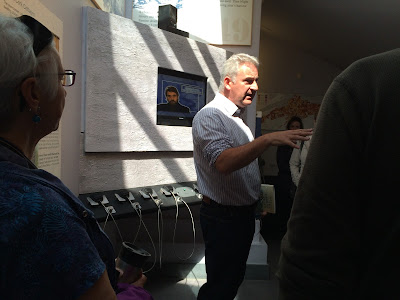Did the old songs taunt or cheer you
And did they still make you cry?
Did you count the months and years
Or did your teardrops quickly dry?
And did they still make you cry?
Did you count the months and years
Or did your teardrops quickly dry?
~ from Thousands Are Sailing, written by Phil Chevron*
We started this journey in Skibbereen, a place known for many things - for its music and hospitality - and for the famine - the great hunger, an Gorta Mór.
Ireland has slowly disclosed herself to the world over the years.** The great hunger has often been un-emphasized like one of those family skeletons in the closet - "We don't talk about it." But now there has been an interest in and willingness to talk, to research, to write, and to remember.
The Skibbereen Heritage Center documents the hunger openly and well.*** We had the opportunity to tour it with Philip O'Regan, one of the authors of Skibbereen: The Famine Story.****
It is a desperate story. It is the story of how and why our ancestors left Ireland to settle in the United States (and elsewhere) in the 1800s. It is the tale of crop failure, mass starvation, dysfunctional and disinterested government, ineffective "solutions," and mass emigration. It is a story of life and death. It is a story well told in Philip's lecture and book and by the heritage center. It is a story quietly and powerfully told by the mass grave in Abbeystrowry Cemetery, where thousands of victims of the hunger rest.
The Skibbereen Heritage Center is located in a modern building immediately adjacent to the old soup kitchen. I urge all those who want to understand a bit about Irish history to take some time in Skibbereen.
My photos of Abbeystrowry Cemetery have mostly gone missing. Let me describe it. The cemetery is on a hillside and an upper and lower road (and then the river beyond) boarder it. The ruins of what may be an old chapel stand. And a large section seems vacant. There are a few markers at the edge of this green expanse, but the greater part is left undisturbed. It is here the remains of thousands of victims of the famine - men, women, and children rest together in what have been described as mass graves or burial pits.*****
NOTES:
The Skibbereen Heritage Center is located in a modern building immediately adjacent to the old soup kitchen. I urge all those who want to understand a bit about Irish history to take some time in Skibbereen.
 |
| Philip O'Regan at The Skibbereen Heritage Center. |
 |
| Part of the soup kitchen. |
 |
| Upstairs windows of the soup kitchen. |
 |
| It is a haunting place. |
 |
| The soup kitchen has been used for many things over the intervening years. The story is the county council owns it now - we will see what happens next. |
My photos of Abbeystrowry Cemetery have mostly gone missing. Let me describe it. The cemetery is on a hillside and an upper and lower road (and then the river beyond) boarder it. The ruins of what may be an old chapel stand. And a large section seems vacant. There are a few markers at the edge of this green expanse, but the greater part is left undisturbed. It is here the remains of thousands of victims of the famine - men, women, and children rest together in what have been described as mass graves or burial pits.*****
 |
| Photo by Mike Searle |
 |
| Photo of ruins in Abbeystrowery Cemetery (from the upper road) |
*https://en.wikipedia.org/wiki/Thousands_Are_Sailing, https://en.wikipedia.org/wiki/Philip_Chevron,
Listen here: https://www.youtube.com/watch?v=gc1G7aCpSsI
Listen here: https://www.youtube.com/watch?v=gc1G7aCpSsI
**http://www.skibbheritage.com/
***http://www.skibbheritage.com/
**** http://www.skibbheritage.com/faminestory.htm (available at the heritage center and on Amazon)
*****We were a solemn group. It brought home the tales of locals "Kids would be playing in the cemetery and come home with a bone. They were sticking out of the ground down there."
See also: http://www.findagrave.com/cgi-bin/fg.cgi?page=cr&CRid=2225743 and
http://historicgraves.com/graveyard/abbeystrowry/co-absy
***http://www.skibbheritage.com/
**** http://www.skibbheritage.com/faminestory.htm (available at the heritage center and on Amazon)
*****We were a solemn group. It brought home the tales of locals "Kids would be playing in the cemetery and come home with a bone. They were sticking out of the ground down there."
See also: http://www.findagrave.com/cgi-bin/fg.cgi?page=cr&CRid=2225743 and
http://historicgraves.com/graveyard/abbeystrowry/co-absy
http://www.southernstar.ie/news/roundup/articles/2016/08/14/4124460-mass-famine-burial-ground-is-revealed-in-skibbereen/
ReplyDelete